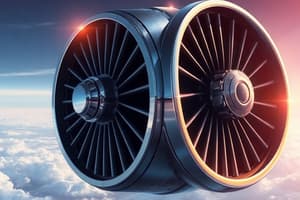Podcast
Questions and Answers
What was the primary purpose of the earliest fire engines?
What was the primary purpose of the earliest fire engines?
- Transporting firefighters to the fire scene
- Pumping water to extinguish fires (correct)
- Clearing roads for faster travel
- Signaling fire locations with loud noises
Before the introduction of fire hydrants, where did early fire engines typically obtain water?
Before the introduction of fire hydrants, where did early fire engines typically obtain water?
- Distant reservoirs transported by horses
- Underground pipelines connected to rivers
- Rainwater collected in large barrels
- Nearby wells or lakes (correct)
In the 1800s, what feature was added to fire engines to allow firefighters to ride on them?
In the 1800s, what feature was added to fire engines to allow firefighters to ride on them?
- Running boards and steps (correct)
- Steam-powered propulsion systems
- Enclosed cabins with seating
- Larger water tanks
What auditory signals were used by fire engines in the 1800s instead of modern sirens?
What auditory signals were used by fire engines in the 1800s instead of modern sirens?
Why were ladders added to fire engines starting in the 1930s?
Why were ladders added to fire engines starting in the 1930s?
What is the function of 'elevating cylinders' on a fire engine equipped with a ladder?
What is the function of 'elevating cylinders' on a fire engine equipped with a ladder?
Where is the equipment, such as hatchets and coats, typically stored on a modern fire engine?
Where is the equipment, such as hatchets and coats, typically stored on a modern fire engine?
What component on a fire engine controls the water flowing out of a fire hydrant through the hoses?
What component on a fire engine controls the water flowing out of a fire hydrant through the hoses?
What is the primary purpose of a siren on a fire engine?
What is the primary purpose of a siren on a fire engine?
Compared to fire engines used 70 years ago, what is cited as a main change in today's fire engines?
Compared to fire engines used 70 years ago, what is cited as a main change in today's fire engines?
Flashcards
Ladder on a fire engine
Ladder on a fire engine
The large, extendable piece of equipment on some fire engines, allowing firefighters to reach high floors of buildings.
Fire hoses
Fire hoses
The tubes that connect a fire engine to a water source and are used to spray water onto a fire.
Pumps on a fire engine
Pumps on a fire engine
These are used to push water from the fire hydrant through the hoses and onto the fire.
Storage compartments on fire engines
Storage compartments on fire engines
Signup and view all the flashcards
Siren on a fire engine
Siren on a fire engine
Signup and view all the flashcards
Early fire engines
Early fire engines
Signup and view all the flashcards
Fire engine propulsion
Fire engine propulsion
Signup and view all the flashcards
Fire hydrant system
Fire hydrant system
Signup and view all the flashcards
Elevating cylinders on fire engines
Elevating cylinders on fire engines
Signup and view all the flashcards
Technology in firefighting
Technology in firefighting
Signup and view all the flashcards
Study Notes
Fire Engine Evolution
- Early fire engines (1700s) were water pumps on wheels, pulled by horses or people.
- They lacked fire hydrants, drawing water from nearby wells or lakes.
- Their primary function was pumping water to extinguish fires.
Engine Enhancements (1800s-1900s)
- Running boards and steps were added to allow firefighters to ride the engine to fire scenes (1800s)
- Fire engines began using horns and bells instead of modern sirens.
- Ladders were added to engines in the 1930s to reach higher floors in tall buildings.
Modern Fire Engines
- Modern fire engines resemble their 70-year-old counterparts.
- Key advancements center on firefighter equipment improvements and technology integration.
- Technology aids in quick response, firefighter location tracking, and safety.
Fire Engine Components
Ladder
- The ladder is used by firefighters to access higher floors of buildings.
- Not all fire engines have ladders.
Hoses
- Firefighters use hoses to direct water onto the fire.
- Hoses connect to the engine's pumps, which control the water flow from fire hydrants
Storage Compartments
- The engine has storage compartments for firefighter equipment (e.g., hatchets, hats, coats, boots, and tools).
Elevating Cylinders
- Some, taller ladder fire engines use elevating cylinders to raise the ladder.
- Elevating cylinders function similarly to elevators.
Siren and Flashing Lights
- The siren warns people of approaching fire engines to avoid getting in the way.
- Flashing lights, typically red or sometimes blue, also serve as a warning.
Orange Cones
- Orange cones are used to designate a danger zone around a fire.
- Cones indicate danger and encourage people to stay back away from the fire scene.
Pump Panel
- Firefighters control the water pump through the pump panel with its numerous dials and controls.
Studying That Suits You
Use AI to generate personalized quizzes and flashcards to suit your learning preferences.




